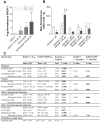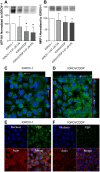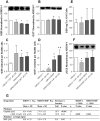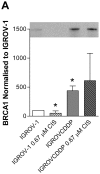Resistance to paclitaxel in a cisplatin-resistant ovarian cancer cell line is mediated by P-glycoprotein
- PMID: 22792399
- PMCID: PMC3394717
- DOI: 10.1371/journal.pone.0040717
Resistance to paclitaxel in a cisplatin-resistant ovarian cancer cell line is mediated by P-glycoprotein
Abstract
The IGROVCDDP cisplatin-resistant ovarian cancer cell line is also resistant to paclitaxel and models the resistance phenotype of relapsed ovarian cancer patients after first-line platinum/taxane chemotherapy. A TaqMan low-density array (TLDA) was used to characterise the expression of 380 genes associated with chemotherapy resistance in IGROVCDDP cells. Paclitaxel resistance in IGROVCDDP is mediated by gene and protein overexpression of P-glycoprotein and the protein is functionally active. Cisplatin resistance was not reversed by elacridar, confirming that cisplatin is not a P-glycoprotein substrate. Cisplatin resistance in IGROVCDDP is multifactorial and is mediated in part by the glutathione pathway and decreased accumulation of drug. Total cellular glutathione was not increased. However, the enzyme activity of GSR and GGT1 were up-regulated. The cellular localisation of copper transporter CTR1 changed from membrane associated in IGROV-1 to cytoplasmic in IGROVCDDP. This may mediate the previously reported accumulation defect. There was decreased expression of the sodium potassium pump (ATP1A), MRP1 and FBP which all have been previously associated with platinum accumulation defects in platinum-resistant cell lines. Cellular localisation of MRP1 was also altered in IGROVCDDP shifting basolaterally, compared to IGROV-1. BRCA1 was also up-regulated at the gene and protein level. The overexpression of P-glycoprotein in a resistant model developed with cisplatin is unusual. This demonstrates that P-glycoprotein can be up-regulated as a generalised stress response rather than as a specific response to a substrate. Mechanisms characterised in IGROVCDDP cells may be applicable to relapsed ovarian cancer patients treated with frontline platinum/taxane chemotherapy.
Conflict of interest statement
Figures





Similar articles
-
The EMT-activator ZEB1 is unrelated to platinum drug resistance in ovarian cancer but is predictive of survival.Hum Cell. 2022 Sep;35(5):1547-1559. doi: 10.1007/s13577-022-00744-y. Epub 2022 Jul 6. Hum Cell. 2022. PMID: 35794446 Free PMC article.
-
Multidrug resistant lncRNA profile in chemotherapeutic sensitive and resistant ovarian cancer cells.J Cell Physiol. 2018 Jun;233(6):5034-5043. doi: 10.1002/jcp.26369. Epub 2018 Jan 2. J Cell Physiol. 2018. PMID: 29219179
-
Collateral sensitivity to cisplatin in KB-8-5-11 drug-resistant cancer cells.Anticancer Res. 2014 Jan;34(1):503-7. Anticancer Res. 2014. PMID: 24403508
-
Copper transporters and the cellular pharmacology of the platinum-containing cancer drugs.Mol Pharmacol. 2010 Jun;77(6):887-94. doi: 10.1124/mol.109.063172. Epub 2010 Feb 16. Mol Pharmacol. 2010. PMID: 20159940 Free PMC article. Review.
-
Role of the human high-affinity copper transporter in copper homeostasis regulation and cisplatin sensitivity in cancer chemotherapy.Cancer Res. 2012 Sep 15;72(18):4616-21. doi: 10.1158/0008-5472.CAN-12-0888. Epub 2012 Sep 7. Cancer Res. 2012. PMID: 22962276 Free PMC article. Review.
Cited by
-
The Transcoelomic Ecosystem and Epithelial Ovarian Cancer Dissemination.Front Endocrinol (Lausanne). 2022 Apr 28;13:886533. doi: 10.3389/fendo.2022.886533. eCollection 2022. Front Endocrinol (Lausanne). 2022. PMID: 35574025 Free PMC article. Review.
-
Do we have biomarkers to predict response to neoadjuvant and adjuvant chemotherapy and immunotherapy in bladder cancer?Transl Androl Urol. 2017 Dec;6(6):1067-1080. doi: 10.21037/tau.2017.09.18. Transl Androl Urol. 2017. PMID: 29354494 Free PMC article. Review.
-
Therapeutic Potential and Utility of Elacridar with Respect to P-glycoprotein Inhibition: An Insight from the Published In Vitro, Preclinical and Clinical Studies.Eur J Drug Metab Pharmacokinet. 2017 Dec;42(6):915-933. doi: 10.1007/s13318-017-0411-4. Eur J Drug Metab Pharmacokinet. 2017. PMID: 28374336 Review.
-
P-glycoprotein mediates drug resistance via a novel mechanism involving lysosomal sequestration.J Biol Chem. 2013 Nov 1;288(44):31761-71. doi: 10.1074/jbc.M113.514091. Epub 2013 Sep 23. J Biol Chem. 2013. PMID: 24062304 Free PMC article.
-
miR-145 sensitizes gallbladder cancer to cisplatin by regulating multidrug resistance associated protein 1.Tumour Biol. 2016 Aug;37(8):10553-62. doi: 10.1007/s13277-016-4957-6. Epub 2016 Feb 8. Tumour Biol. 2016. PMID: 26852750
References
-
- Hennessy BT, Coleman RL, Markman M. Ovarian cancer. Lancet. 2009;374:1371–1382. - PubMed
-
- Stordal B, Pavlakis N, Davey R. A systematic review of platinum and taxane resistance from bench to clinic: an inverse relationship. Cancer Treatment Reviews. 2007;33:688–703. - PubMed
-
- Ma J, Maliepaard M, Kolker HJ, Verweij J, Schellens JH. Abrogated energy-dependent uptake of cisplatin in a cisplatin-resistant subline of the human ovarian cancer cell line IGROV-1. Cancer Chemotherapy & Pharmacology. 1998;41:186–192. - PubMed
-
- Ma J, Maliepaard M, Nooter K, Boersma AW, Verweij J, et al. Synergistic cytotoxicity of cisplatin and topotecan or SN-38 in a panel of eight solid-tumor cell lines in vitro. Cancer Chemotherapy & Pharmacology. 1998;41:307–316. - PubMed
-
- Martin A, Clynes M. Comparison of 5 microplate colorimetric assays for in vitro cytotoxicity testing and cell proliferation assays. Cytotechnology. 1993;11:49–58. - PubMed
Publication types
MeSH terms
Substances
Grants and funding
LinkOut - more resources
Full Text Sources
Medical
Research Materials
Miscellaneous

